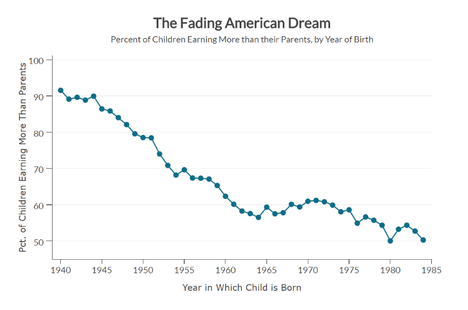(p. A15) Various estimates suggest that had U.S. productivity growth not slowed, GDP would be about $3 trillion higher than it is today.
. . .
Many economists contend that properly counting free digital services from companies like Google and Facebook would substantially boost productivity and GDP growth. One of the highest estimates, calculated by economists Austan Goolsbee and Peter Klenow, stands at $800 billion. That’s a big number, but not big enough to fill a $3 trillion hole.
. . .
In his 2016 book, “The Rise and Fall of American Growth,” Northwestern University economist Robert Gordon contends that the current economy fails to measure up to the great inventions of the past, and that innovation today is more incremental than transformative. He has argued vigorously that the transformative effects of technologies like electric lighting, indoor plumbing, elevators, autos, air travel and television are unlikely to be repeated. Technological innovation, he argues, will not be sufficiently robust to counter the headwinds of slowing population growth, rising inequality and exploding sovereign debt.
Former Treasury Secretary Larry Summers has resurrected Alvin Hansen’s 1938 theory of secular stagnation. Morgan Stanley economist Ruchir Sharma has argued that a 2% economy is the new normal. Former Fed Chairman Alan Greenspan has repeatedly said that the growing share of social benefits and entitlements in GDP crowds out national savings and reduces investments required to boost productivity growth.
The growth dividends from disruptive technology often require time before they are widely diffused and used. To Mr. Gordon’s point, economic historians respond that the Industrial Revolution did not improve British living standards for almost a century. Likewise the productivity boost spurred by the transformative innovations of the early 20th century took decades to kick in.
In the short term, as companies try to develop online capabilities while maintaining a physical presence, some costs are duplicated.
. . .
It’s possible that economic dynamism and entrepreneurship are no longer driving the U.S. economy. Startups are being created at a slower pace. From 1996 to 2007 the ratio of new firms to the total number of firms oscillated between 9.6 and 11.2. Today it has dropped to 7.8. Existing firms do innovate and contribute to improved productivity, but the declining share of young firms suggests a less dynamic economy.
Concurrently, the most recent numbers from the Bureau of Labor Statistics confirm that churn in the U.S. labor market remains weak across industries, regions and age groups. People are simply not moving or changing jobs for better alternatives.
. . .
The real debate is about policies that favor productivity and GDP growth. Predicting future innovation is hazardous, but deregulation and streamlined licensing requirements will facilitate job mobility. Tax reform that encourages and rewards investment should stimulate capital investment.
. . .
These necessary policy changes provide options for improving productivity and GDP growth. Waiting for the data debate to resolve itself gets us nowhere.
For the full commentary, see:
Brian Switek. “The Great Productivity Slowdown; It began long before the financial crisis, and it has worsened markedly in the past six years.” The Wall Street Journal (Fri., May 5, 2017): A15.
(Note: ellipses added.)
(Note: the online version of the commentary has the date May 4, 2017.)
The Goolsbee and Klenow article mentioned above, is:
Goolsbee, Austan, and Peter J. Klenow. “Valuing Consumer Products by the Time Spent Using Them: An Application to the Internet.” American Economic Review 96, no. 2 (May 2006): 108-13.

